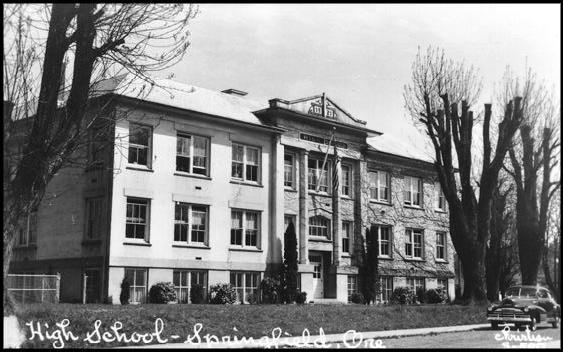Springfield High School
From Lane Co Oregon
Contents |
History
Foundation
By 1854 Springfield had its first school, probably near 7th Street and B Street, and a teacher, Agnes Stewart. By 1870, the population of Springfield had grown to nearly 650 before the Oregon and California Railroad was persuaded to cross the Willamette near Harrisburg and go through Eugene. River navigators also could not get beyond the Eugene area to Springfield except during floods. The developments were a severe blow to Springfield to the extent that the population dwindled less than 400 by 1890.[1]
Although progress was slowed, Springfield continued to refine its town. In 1885 the two-room school house at Mill Street and D Streets had over 60 students. Eugene with the railroad and a university, was developing much faster as a service and trade center.[1]
For Springfield, change came in 1891 with a rail line and a new steel bridge. By then, Springfield had two schools in addition to three hotels, three churches, two groceries, a meat market, a shoe store, a drug store, two blacksmiths and a couple of general merchandise stores.[1]
Education was limited to the eighth grade, which was a concern for those who sought higher education at the university. It was also a concern for those who taught at the university. Incoming students were rarely prepared for the requirements of a university education and needed extra preparatory help. By the mid 1890s the University of Oregon president was encouraging the establishment of high schools to help serve this need. Eugene was already graduating more than 100 students from its eighth grade. Springfield had barely 10 percent of that number. By 1900, the population of Springfield still languished around 350. However, the milling boom was beginning, and in 1902, a large modern and economical mill was built in Springfield by the Booth-Kelly Company. In less than 10 years the population of Springfield grew to about 2,500.[1]
The earliest records of SHS activities include reports or student performances. In an April 1909 edition of the student publication Nonpariel, Lloyd Emery, an SHS junior at the time, reports that the traditional senior play was expanded to include the entire school population to perform "The Devil in Society." Apparently late rehearsals were as common then as now. The writer went on to say, "it does not seem to agree with the High School pupils to stay up late for a few nights in succession, for the day after the play it kept the teachers busy keeping the pupils awake." He added, though, "but it was worth the time and the sleep lost, just the same."[3]
1910s
By 1912, 70 students had enrolled in the school. Early in the 1913-1914 school year, the students initiated a campaign to encourage prospective pupils to enroll at SHS. They strung a large canvas downtown to advertise the school and even made personal visits to enlist more youths. By February, the student population nearly reached the 100 mark. According to the SHS Annual, "when on February 27, it was discovered that the one-hundredth student was actually in attendance, the enthusiasm of the school knew no bounds and a holiday, to celebrate the occasion, was voted by the students and approved by the Board of Directors." The students then proceeded to parade the main streets of Springfield in the drizzling rain, led by a bugler and an array of banners and placards announcing the holiday.[2]
By all accounts, the student body of that year was a tightly knit group of friends who showed great enthusiasm for their school. Junior Walter Bailey, the President of the Student Body, wrote an essay in the 1914 Annual titled "Why Springfield High Is the School for Me." Bailey, who attended Eugene High School as a freshman, wrote, "I have nothing to say against the Purple and the White, but I have a great deal to say for the Blue and the White. I can say without exaggeration that I never met a more congenial and cordial group of students than I found in Springfield." Bailey notes the lack of cliques at his school and the general spirit of unity among the student body. "We are many in number but one in strength and purpose."[2]
[1] The Millers: History of Springfield High School, editor Pat Albright, 8-9.
[2] Ibid., 12.
[3] Ibid., 24.
Administration
Springfield High School Principals
Flavius Roberts 1906-1907
H.C. Baughman 1907-1912
J.E. Torbert 1923-1924
L.E. Marschatt 1935-1936
Glen Martin 1936-1938
Cecil H. Davis 1938-1944
Owen Sabin 1944-1952
Warne Empey 1952-1956
Dale Parnell 1956-1961
Charles Smith 1961-1964
Ron Schiessl 1985-1994
Gene Heinle 1994-
Springfield High Head Coaches
Football Coaches
| Football Coaches | |||
| 1915- | Rex Putnam | 1921 | "Mack" McFadden |
| 1922 | Harold Barto | 1927 | Harold Finwick |
| 1933-37 | Marion Hall | 1937-1941 | Eldon Fix |
| 1943-1944 | John Young | 1946 | Bob Johnson |
| 1948 | John Young | 1950-1951 | Paul Evenson |
| 1952-1954 | George Zellick | 1958-1959 | Hal Whitbeck |
| 1962-1964 | Shelby Price | 1965 | Lee Insko |
| 1966 | JC Johnson | 1968-1970 | Jack Morris |
| 1971-1976 | Bob Harris | 1977-1979 | Vern Allers |
| 1979-1983 | Chuck Burns | 1984-1993 | Bob McKenzie |
| 1994-1998 | Ron Simmons | ||
| Baseball Coaches | |||
| 1914 | BH Smith | 1922 | "Mack" McFadden |
| 1923 | George Bliss | 1924 | Lester Wilcox |
| 1927 | Leonard Mayfield | 1934 | Kernal Buhler |
| 1935 | Robert Chatterton | 1937 | Harold Santee |
| 1938-1941 | Eldon Fix | 1942 | Paul Johnston |
| 1945-1953 | John Young | 1954 | Roger Wiley |
| 1955-1963 | John Young | 1964-1977 | Terry Maddox |
| 1977-1981 | Jim Fryback | 1982-95 | Bill Bowers |
| 1996-97 | Jason Hawkins | 1998 | Jim Fryback |

